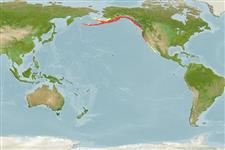Classification / Names
Common names from other countries
Main reference
Size / Weight / Age
Max length : 63.0 cm TL male/unsexed; (Ref. 27437); max. published weight: 4.8 kg (Ref. 2850); max. reported age: 50 years (Ref. 39247)
Length at first maturity
Lm 40.2, range 30 - 42 cm
Environment
Marine; reef-associated; depth range 0 - 366 m (Ref. 6885), usually 183 - 274 m (Ref. 6885)
Climate / Range
Temperate, preferred 10°C (Ref. 107945); 62°N - 22°N, 170°E - 110°W
Distribution
Short description
Dorsal
spines
(total): 13 - 14;
Dorsal
soft rays
(total): 13-16;
Anal
spines: 3;
Anal
soft rays: 7 - 9;
Vertebrae: 26. Head spines weak to very weak - nasals present, preocular and postocular spines usually absent, supraocular, tympanic, coronal, parietal and nuchal spines absent (Ref. 27437). Symphyseal knob very weak or absent (Ref. 27437). Eyes moderately large (Ref. 27437). Anal fin profile rounded or with greater portion slanted posteriorly (Ref. 27437). Posterior margin of caudal fin indented (Ref. 27437). Dark grey to black with light grey mottling dorsally, lighter ventrally (Ref. 27437). Branchiostegal rays: 7 (Ref. 36715).
IUCN Red List Status (Ref. 115185)
Threat to humans
Harmless
Human uses
Fisheries: minor commercial; gamefish: yes; aquarium: public aquariums
More information
ReferencesAquacultureAquaculture profileStrainsGeneticsAllele frequenciesHeritabilityDiseasesProcessingMass conversion
Tools
Special reports
Download XML
Internet sources
Estimates of some properties based on models
Phylogenetic diversity index
PD50 = 0.5000 many relatives (e.g. carps) 0.5 - 2.0 few relatives (e.g. lungfishes)
Trophic Level
4.4 ±0.0 se; Based on diet studies.
Resilience
Low, minimum population doubling time 4.5 - 14 years (tm=7.5; K=0.14; tmax=50)
Vulnerability
High to very high vulnerability (66 of 100)
Price category
